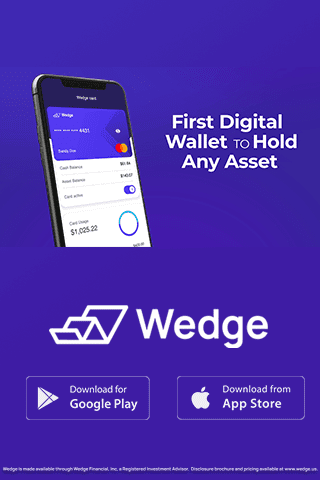Demonstrating the mobile version of his company’s product, Billy Roberts goes through the all-too-familiar motions that so many people everywhere perform multiple times a day on their smartphones.
The Wedge chief executive officer moves funds to pay for $10 worth of his go-to coffee, frappucinos, or sandwiches from Starbucks. But instead of transferring money from a checking account, Roberts uses profits from his stock in Roblox to pay for it.

In December, Wedge brought its US product to AppMarket from Fiserv, the multinational fintech services giant based in Wisconsin, where financial institutions can more easily access its technology.
Two months later, on February 15, Wedge added another significant partnership: with Visa, to launch a debit card connected to the Wedge app.
Wedge’s fintech product lets users spend from balances held at separate banks and financial platforms — including stocks, cryptocurrencies, neo-banking, exchange-traded funds, and cash — in many ways simplifying their digital wallets in the process.
Card connected to ‘different stores of value’
“What we built with our technology, now with a single card, you can kind of have it connected to these different stores of value and work for you in the way that that kind of reflects your financial situation, or how you want to liquidate assets,” said Roberts, whose firm is based in Austin, Tex.
Wedge was founded in January 2021 by Roberts and Alexander Duvall, the firm’s chief technology officer. They had been colleagues at Roberts’s previous venture, software firm Restream Solutions, which was sold to a private equity firm in 2020.
“I just really loved working with Alex. We saw some real opportunity in the fintech space around how to solve some of the issues we saw with fragmentation,” Roberts said. “There were all these different fintech apps folks had: five or six other apps on their phone at one point to do stock trading or neo-banking or crypto or whatever.
“Along with that fragmentation were a lot of redundant cost structures associated with (connecting) to accounts and moving money from point A to point B, and some interesting limitations on the engagement data. Folks would download an app; you have this honeymoon period where it’s cool and interesting, then usage tapers off for a lot of them because while they might be novel, they’re not necessarily useful on a day-to-day basis.”
A ‘daily companion’
The challenge for Roberts, Duvall, and co.: develop a “daily companion” for users, a single place where they can access funds from a variety of their assets.
“Today, most card products or payment products are reflections of the institutions through which they’re issued so that you may have an American Express or a Chase Sapphire or a Wells Fargo debit card,” Roberts said.
“Our approach was, ‘how do we make the card a reflection of the user, the same way that the iPhone made the phone a reflection of the user, as a conduit to the cell networks?’ Really, though, folks populate it with the things that are interesting to them. It becomes something that’s more bespoke and useful.”
Folks populate it with the things that are interesting to them. It becomes something more bespoke and useful.
The Wedge team went to market with the direct consumer product a year ago this month, the single card connected to different stores of value.
“It can work for you in a way that reflects your financial situation or how you want to liquidate assets … That was the thesis,” Roberts said.

Seeking more scale
Wedge’s long-term strategy: adjacency with users’ primary accounts through their preferred financial institutions.
“That’s really the next iteration of Wedge,” Roberts said. “We’ve developed the relationships and the infrastructure to deploy this technology through someone’s existing bank through the banking quarters themselves. That’s one thing we get excited about because as soon as you do that, you bring this functional capability into a bank, get the security, trust, and infrastructure to supercharge someone’s financial well-being.”
Halfway through 2022, the Wedge team sought out more partnerships, leading to the recent deals with Visa and Fiserv, “wanting to put some gas in the fire associated with (the strategy of) getting more scale and more seamlessly integrate with the banks,” Roberts said.
“Knock on wood; we feel really good about our tech stack. We’ve got the two biggest players in the payments and the processing spaces partnered up,” he said.
“Our real goal, for now, is to get Wedge in the hands of as many banks and bank customers as possible. We feel really strongly, with the customer data we have today, in the early interest we’ve had from some of those banking partners, that having this new capability tied to someone’s primary checking account within their mobile banking experience could be impactful. That’s what we’re most excited about. We feel like we’ve got the pieces in place to execute on that this year.”


